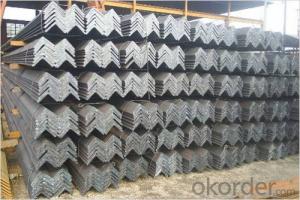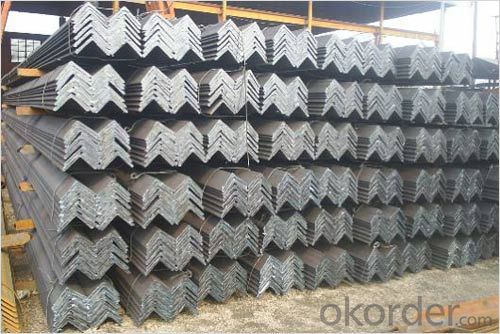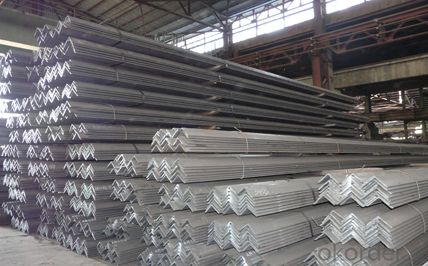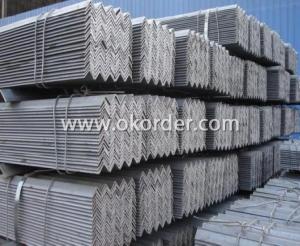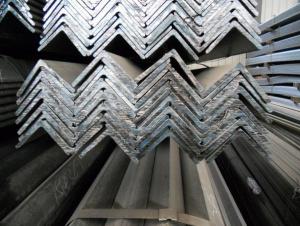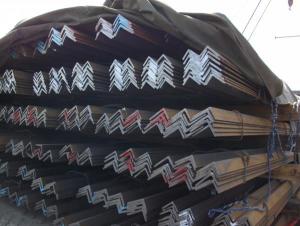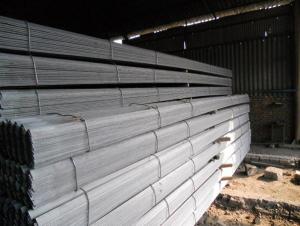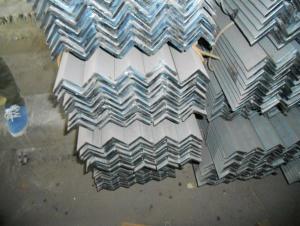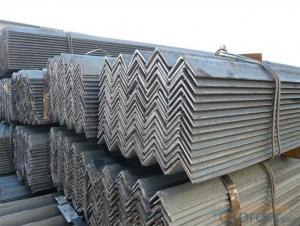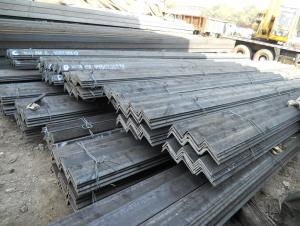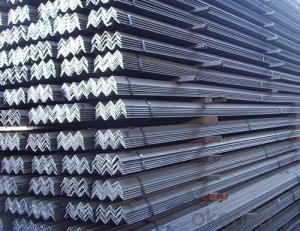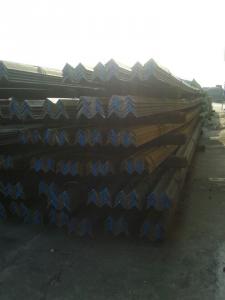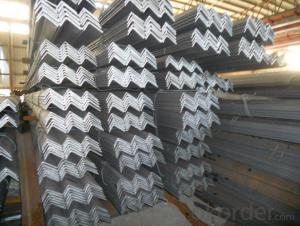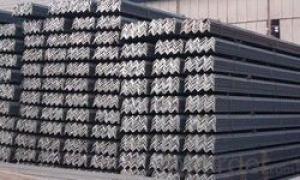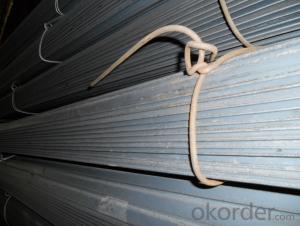Steel Equal Angle Hot Rolled Steel Profile Carbon Equal Angle
- Loading Port:
- Tianjin
- Payment Terms:
- TT or LC
- Min Order Qty:
- 28 m.t.
- Supply Capability:
- 35000 m.t./month
OKorder Service Pledge
OKorder Financial Service
You Might Also Like
Product Description of Steel Equal Angle Hot Rolled Steel Profile Carbon Equal Angle:
OKorder is offeringHot Rolled Steel Equal Angle Unequal Angle at great prices with worldwide shipping. Our supplier is a world-class manufacturer of steel, with our products utilized the world over. OKorder annually supplies products to European, North American and Asian markets. We provide quotations within 24 hours of receiving an inquiry and guarantee competitive prices.
Product Applications of Steel Equal Angle Hot Rolled Steel Profile Carbon Equal Angle:
Hot Rolled Steel Equal Angle Unequal Angle are ideal for structural applications and are widely used in the construction of buildings and bridges, and the manufacturing, petrochemical, and transportation industries.
Product Advantages of Steel Equal Angle Hot Rolled Steel Profile Carbon Equal Angle:
OKorder's Hot Rolled Steel Equal Angle Unequal Angle are durable, strong, and resist corrosion.
Main Product Features of Steel Equal Angle Hot Rolled Steel Profile Carbon Equal Angle:
· Premium quality
· Prompt delivery & seaworthy packing (30 days after receiving deposit)
· Corrosion resistance
· Can be recycled and reused
· Mill test certification
· Professional Service
· Competitive pricing
Product Specifications of Steel Equal Angle Hot Rolled Steel Profile Carbon Equal Angle:
Specifications of Angle Steel
1. Invoicing on theoretical weight or actual weight as customer request
2. Length: 6m, 9m, 12m as following table
3. Sizes
Sizes: 25mm-250mm | ||
a*t | ||
25*2.5-4.0 | 70*6.0-9.0 | 130*9.0-15 |
30*2.5-6.6 | 75*6.0-9.0 | 140*10-14 |
36*3.0-5.0 | 80*5.0-10 | 150*10-20 |
38*2.3-6.0 | 90*7.0-10 | 160*10-16 |
40*3.0-5.0 | 100*6.0-12 | 175*12-15 |
45*4.0-6.0 | 110*8.0-10 | 180*12-18 |
50*4.0-6.0 | 120*6.0-15 | 200*14-25 |
60*4.0-8.0 | 125*8.0-14 | 250*25 |
5. Payment terms:
1).100% irrevocable L/C at sight.
2).30% T/T prepaid and the balance against the copy of B/L.
3).30% T/T prepaid and the balance against L/C
6.Material details:
Alloy No | Grade | Element (%) | |||||
C | Mn | S | P | Si | |||
|
|
|
|
|
|
| |
Q235 | B | 0.12—0.20 | 0.3—0.7 | ≤0.045 | ≤0.045 | ≤0.3 | |
|
|
|
|
|
|
| |
Alloy No | Grade | Yielding strength point( Mpa) | |||||
Thickness (mm) | |||||||
≤16 | >16--40 | >40--60 | >60--100 | ||||
≥ | |||||||
|
|
|
|
|
| ||
Q235 | B | 235 | 225 | 215 | 205 | ||
Alloy No | Grade | Tensile strength (Mpa) | Elongation after fracture (%) | ||||
Thickness (mm) | |||||||
| ≤16 | >16--40 | >40--60 | >60--100 | |||
≥ | |||||||
|
|
|
|
|
|
| |
Q235 | B | 375--500 | 26 | 25 | 24 | 23 | |
Usage & Applications of Steel Equal Angle Hot Rolled Steel Profile Carbon Equal Angle
According to the needs of different structures, Angle can compose to different force support component, and also can be the connections between components. It is widely used in various building structures and engineering structures such as roof beams, bridges, transmission towers, hoisting machinery and transport machinery, ships, industrial furnaces, reaction tower, container frame and warehouse etc.
Packaging & Delivery of Steel Equal Angle Hot Rolled Steel Profile Carbon Equal Angle
1. Packing: it is nude packed in bundles by steel wire rod
2. Bundle weight: not more than 3.5MT for bulk vessel; less than 3 MT for container load
3. Marks:
Color marking: There will be color marking on both end of the bundle for the cargo delivered by bulk vessel. That makes it easily to distinguish at the destination port.
Tag mark: there will be tag mark tied up on the bundles. The information usually including supplier logo and name, product name, made in China, shipping marks and other information request by the customer.
If loading by container the marking is not needed, but we will prepare it as customer request.
Production flow of Angle Steel
Material prepare (billet) —heat up—rough rolling—precision rolling—cooling—packing—storage and transportation
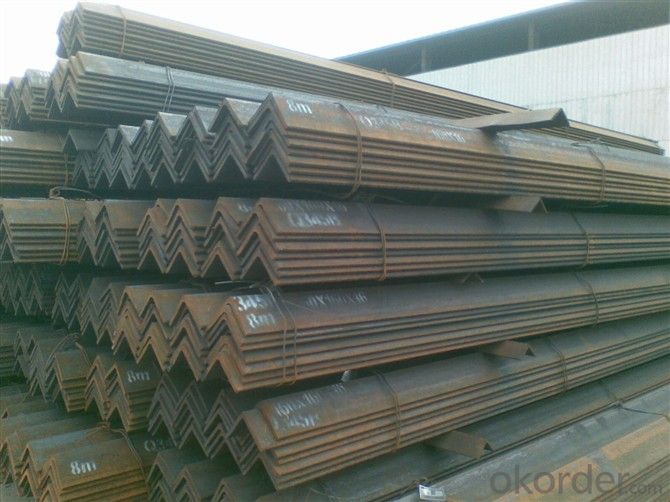
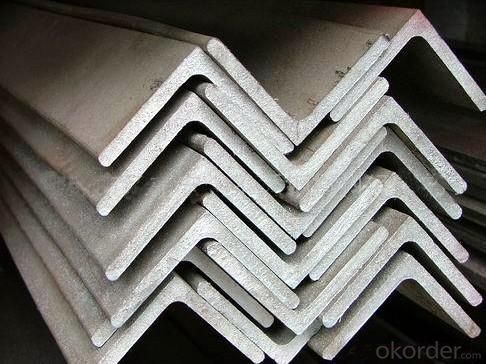
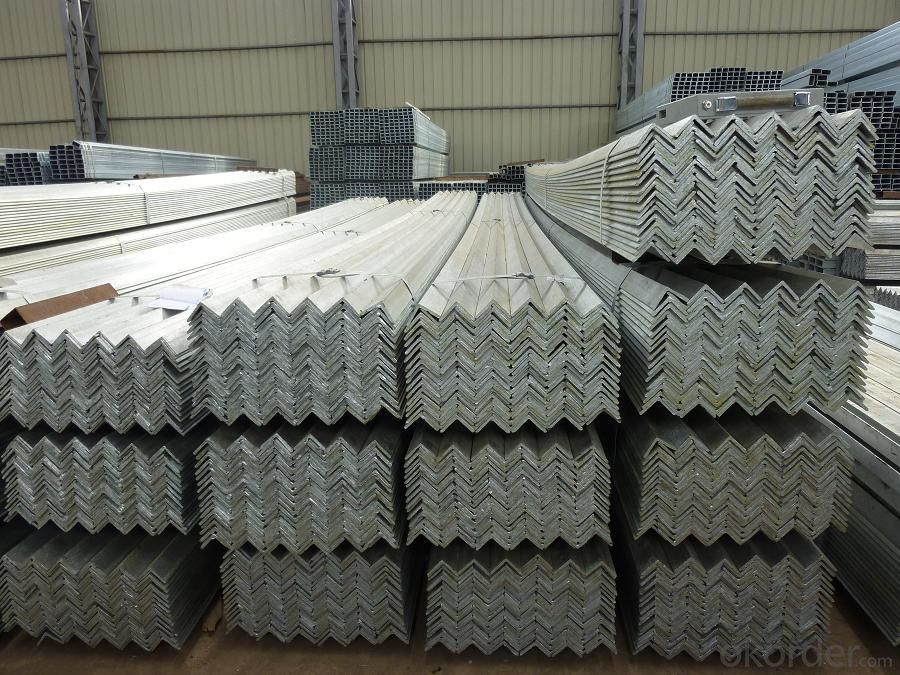
- Q: How do you measure the dimensions of a steel angle?
- To determine the dimensions of a steel angle, a combination of tools such as a measuring tape or ruler, a protractor, and a square can be used. Begin by measuring the length of one side of the angle using a measuring tape or ruler. Position the tape or ruler along the side of the angle and observe the measurement. Subsequently, measure the length of the other side of the angle in the same manner. Ensure that the starting point is the same as the first side for precise results. For measuring the angle itself, employ a protractor. Align the protractor's base with one side of the angle and verify that the other side corresponds to the appropriate degree marking on the protractor. Consult the protractor's reading to ascertain the angle of the steel angle. Lastly, a square can be utilized to confirm if the angle truly measures 90 degrees. Place the square against the two sides of the angle and confirm that it perfectly aligns with both sides. If alignment is achieved, then the angle is, indeed, 90 degrees. Please bear in mind that these measurements may be approximate and could slightly differ due to manufacturing tolerances.
- Q: What are the different grades of steel used for angles?
- The different grades of steel commonly used for angles include A36, A572, and A588.
- Q: Can steel angles be used for machine guards?
- Indeed, machine guards can utilize steel angles as a viable option. Renowned for their robustness and endurance, steel angles find prominent usage within the construction sector. These angles can be effortlessly manipulated and affixed to form a protective enclosure around machinery, effectively safeguarding workers and averting mishaps. The adaptability of steel angles permits tailoring to accommodate diverse machine dimensions and configurations. Moreover, steel angles exhibit commendable resistance against impacts and can withstand substantial burdens, rendering them apt for employment in machine guarding endeavors.
- Q: How do steel angles compare to wooden beams?
- Steel angles and wooden beams possess distinct characteristics and abilities that render them suitable for diverse applications. Steel angles, being comprised of steel, demonstrate exceptional strength and longevity. They exhibit remarkable tensile strength and resist bending and warping even when subjected to substantial loads. This renders them an excellent choice for providing structural support in constructions such as buildings, bridges, and other similar projects. Moreover, steel angles possess the advantage of being non-combustible, thereby enhancing fire safety. Conversely, wooden beams offer their own set of advantages. As a natural material, wood is readily accessible and renewable, making it a more environmentally conscious option when compared to steel. Additionally, wooden beams possess an inherent aesthetic appeal, particularly in traditional or rustic designs. They can be effortlessly customized and shaped, enabling the creation of intricate and imaginative designs. Nevertheless, wooden beams do have certain limitations with regards to strength and durability. They do not exhibit the same level of robustness as steel angles and are susceptible to bending, warping, and rotting over time. Additionally, wood is combustible, which can pose safety concerns. In conclusion, both steel angles and wooden beams possess their own unique strengths and weaknesses. Steel angles excel in projects necessitating high strength and durability, while wooden beams offer a more natural and visually appealing option. Ultimately, the choice between the two depends on specific project requirements, budgetary considerations, and personal preferences.
- Q: Can steel angles be used in electrical or telecommunications installations?
- Yes, steel angles can be used in electrical or telecommunications installations. Steel angles are commonly used as structural supports and mounting brackets in these types of installations due to their strength, durability, and versatility.
- Q: How do steel angles compare to other materials like aluminum or wood?
- Steel angles have several advantages over other materials like aluminum or wood. Firstly, steel angles are known for their strength and durability. Steel is a highly robust material that can withstand heavy loads and high-pressure situations, making it ideal for structural applications. In comparison, aluminum is relatively weaker and less durable, making it better suited for lightweight applications. Secondly, steel angles have excellent fire resistance properties. Steel is non-combustible, which means it does not burn or contribute to the spread of fire. On the other hand, wood is highly flammable and can be a fire hazard in certain situations. Aluminum has a higher melting point than wood, but it does not possess the same level of fire resistance as steel. Moreover, steel angles have superior corrosion resistance compared to both aluminum and wood. Steel can be galvanized or treated with protective coatings to prevent rust and corrosion, making it suitable for outdoor or marine applications. Aluminum, although it has a natural oxide layer that resists corrosion, is still more susceptible to corrosion than steel. Wood, being an organic material, is highly vulnerable to rot and decay when exposed to moisture or insects. Another advantage of steel angles is their versatility. Steel can be easily fabricated and manipulated into various shapes and sizes, allowing for a wide range of design possibilities. Aluminum also offers some flexibility in terms of fabrication, but it is generally less malleable and more prone to cracking. Wood, while being relatively easy to work with, has limitations in terms of structural integrity and design flexibility. In terms of cost, steel angles are generally more economical than aluminum. Steel is widely available and has lower production costs, making it a cost-effective choice for many applications. Aluminum, on the other hand, can be more expensive due to higher production costs and its limited availability. Wood, depending on the type and quality, can vary in price but is often more affordable than steel or aluminum. In summary, steel angles offer superior strength, durability, fire resistance, corrosion resistance, versatility, and cost-effectiveness compared to materials like aluminum or wood. However, the choice of material ultimately depends on the specific application, design requirements, and budget constraints.
- Q: Can steel angles be used for curtain walls?
- Yes, steel angles can be used for curtain walls. Steel angles are often used as a framing member in curtain wall systems due to their strength, durability, and ability to support the weight of the curtain wall. They provide structural support and help in transferring loads from the curtain wall to the building structure.
- Q: Can steel angles be drilled or cut?
- Indeed, it is possible to drill or cut steel angles. Steel angles, being a flexible structural material, find extensive use in diverse construction and manufacturing endeavors. It is effortless to drill them for the purpose of creating holes for bolts, screws, or other fastening elements. Moreover, steel angles can be fashioned into specific lengths or shapes by employing tools like saws, plasma cutters, or shears. The capacity to drill or cut steel angles renders them exceedingly adaptable and fitting for an extensive array of applications.
- Q: How are steel angles protected during transportation and storage?
- To ensure the preservation and quality of steel angles during transportation and storage, various measures are taken. One commonly employed method involves the application of a protective coating or paint to the surfaces of the steel angles. This coating acts as a barrier, shielding the angles from moisture and preventing the occurrence of rust and corrosion. Moreover, plastic wrapping or tarp covering can be utilized to safeguard the angles against dirt, dust, and other contaminants. During transportation, the risk of shifting or falling is minimized by securing the steel angles in bundles or arranging them in a manner that reduces such hazards. Additionally, pallets or skids may be employed to facilitate handling and prevent direct contact with the ground. When stored, it is crucial to keep the steel angles in a well-ventilated and dry area in order to prevent the accumulation of moisture. Furthermore, proper labeling and handling instructions play a vital role in preventing mishandling or damage during transportation. This entails the use of appropriate lifting equipment and avoidance of rough handling that could potentially lead to bending or deformation. By implementing these protective measures, the integrity and quality of steel angles can be upheld throughout the transportation and storage processes, ensuring their readiness for use.
- Q: What are the different types of steel angles used in signage structures?
- Signage structures commonly utilize various types of steel angles to provide structural support and stability. These angles ensure the signage remains secure and can endure different weather conditions. 1. Labeled as equal angles or L-shaped angles, these angles possess identical sides and are frequently employed in signage structures. They establish a robust and sturdy framework for the signage, enabling it to withstand external forces such as wind. 2. Unequal angles, as their name implies, feature sides of differing lengths. They are often utilized in signage structures where different sections of the signage necessitate varying levels of support. These angles can be customized to meet specific design requirements and enhance the stability of the signage. 3. Hollow Structural Sections (HSS) angles are steel angles with a hollow interior. Due to their lightweight nature and high strength-to-weight ratio, these angles are extensively used in signage structures. When constructing large and intricate signage structures, HSS angles are especially beneficial as they reduce overall weight and facilitate easier installation. 4. Corner angles are employed to fortify the corners of signage structures, providing additional support and preventing potential bending or warping. Typically crafted from thicker steel, these angles are designed to withstand significant stress and pressure. 5. Galvanized angles are steel angles coated with a layer of zinc to safeguard against rust and corrosion. They are commonly employed in outdoor signage structures exposed to moisture and other environmental elements. The galvanized coating guarantees the durability and longevity of the angles, hence extending the lifespan of the signage structure. Ultimately, the selection of steel angles for signage structures relies on factors such as signage size, design, expected load and stress, and environmental conditions. By choosing the appropriate type of steel angle, signage structures can be constructed to endure outdoor environments and provide enduring support for a variety of signage types.
Send your message to us
Steel Equal Angle Hot Rolled Steel Profile Carbon Equal Angle
- Loading Port:
- Tianjin
- Payment Terms:
- TT or LC
- Min Order Qty:
- 28 m.t.
- Supply Capability:
- 35000 m.t./month
OKorder Service Pledge
OKorder Financial Service
Similar products
Hot products
Hot Searches
Related keywords
